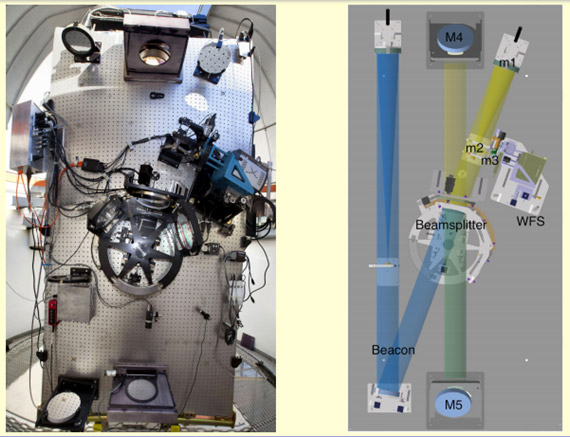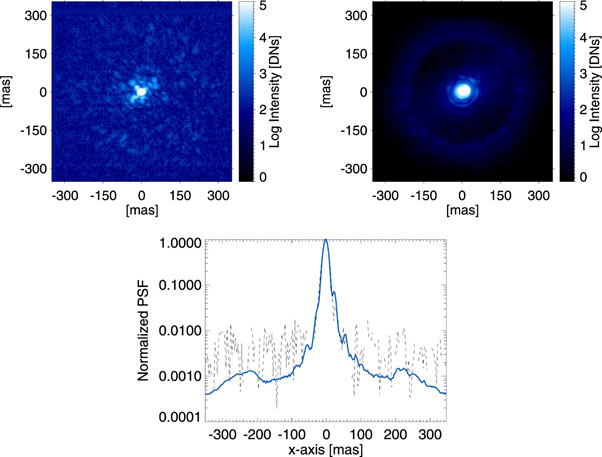Resources
 Part of the Oxford Instruments Group
Part of the Oxford Instruments Group
Expand
Collapse
 Part of the Oxford Instruments Group
Part of the Oxford Instruments Group
As previously mentioned in Introduction to Astronomical Adaptive Optics, the Adaptive optic approach is a powerful tool for minimising the distortions caused by Atmospheric turbulence.
The Shack-Hartmann based Wavefront sensor approach can be seen at The Center for High Angular Resolution Astronomy (CHARA) Array, [2, 3] at the Mount Wilson Observatory. See Figure 1 & 2. The Chara Array is a IR and Near Infrared telescope system comprising of 6 optically connected telescopes, each fitted with an EMCCD (Andor iXon Ultra) based AO system which operates at 1000 frames per second (set up using a 90 x 90 pixel ROI).

Figure 1. Shack Hartmann Adaptive Optic setup at the Chara Array [4]
And alternative AO implementations can be found at The Large Binocular Telescope which utilises a Laser based guide Star, adaptive secondary mirror with 672 actuators and Andor Zyla sCMOS camera operating at 1 kHz (200 x 200 Pixels). [5,6]
The Raven AO system utilises 5 EMCCD cameras and used multiple objects in a field of view to perform Multi-object correction over a very large image plane.[8,9]
Table 1 Shows a broad range of Adaptive Optic systems and the telescopes where they are based.

Figure 2. Top left: short exposure (1 ms) PSF of GLIESE 777. Top right: long exposure (5 s) PSF of GLIESE 777. Bottom: radial profile of both short (dashed line) and long (blue continuous line) exposure PSFs. [7]
| Table 1, A list of Innovative Adaptive Optic systems. | |||
| 1 | Chara Array | Mt Wilson Observatory, CA | iXon 897 EMCCD |
| 2 | Large Binocular Telescope | Mt Graham International Observatory, AZ | Zyla sCMOS |
| 3 | Multi-Object Adaptive Optics (MOAO) | Subaru Telescope, Hawaii | 5 x Zyla |
| 4 | The portable adaptive optics System | Various | iXon 897 EMCCD |
| 5 | The Subaru Coronagraphic Extreme Adaptive Optics (SCExAO) instrument - VAMPIRES | Subaru Telescope, Hawaii | iXon 897 EMCCD |
| 6 | Robo AO | Palomar Observatory, CA | iXon 888 EMCCD |
| 7 | Fastcam | William Herschel Telescope, Canary Islands, Spain | iXon 897 EMCCD |
| 8 | Anglo Australian Telescope AO | Siding Spring Observatory, Australia | Zyla sCMOS |
| 9 | Canary Moao | William Herschel Telescope, Canary Islands, Spain | iXon EMCCD |
